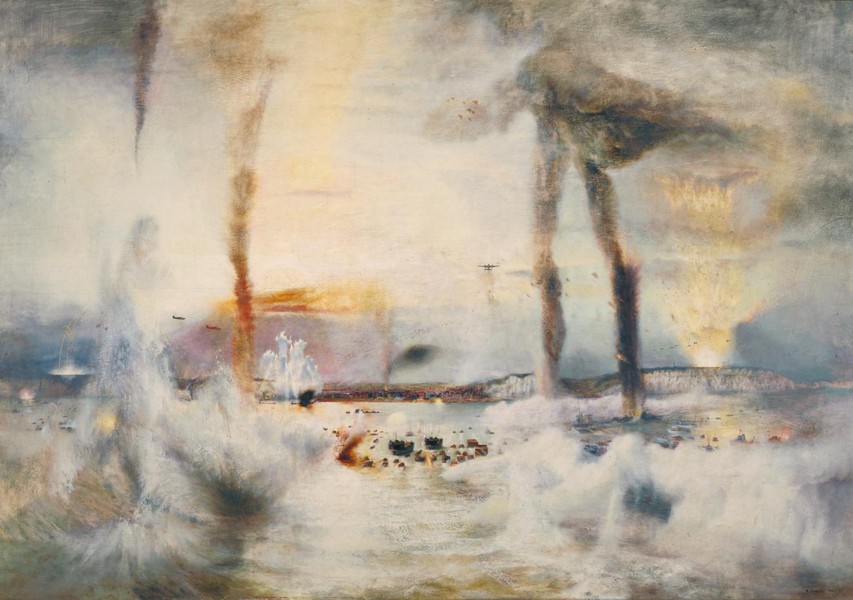

1942-3
Oil on panel
121.9 x 175.3 cm
Works | 1940 to 1949 Narrative Ships | Boats | Harbours | Ports All Works in Public Collections All Works in RA Summer Exhibitions 1937 to 1993 Bonfires | Flames | Smoke Wartime Sunrises | Sunsets Commissioned Works Birds Eye View Official War Artist Seascapes | Coastal Scenes The Art of Richard Eurich
Recto: Signed and dated lower right: R EURICH. 1942-3
Aka: The Landing at Dieppe, 19th August 1942 [Tate; IWM]; Dieppe [RA]; The Raid on Dieppe [Bradford]; Dieppe 1942 [RE sales diary]
Dieppe France Royal Air Force Royal Navy Spitfire Tate WW2 WWII World War 2 World War II air force aircraft attack boats ships clouds destroyer explosion fighter fighter plane landing craft landing ship military munitions dump parachutes paratroops public collection sea ships soldiers troop ships turner-ish war war artist wartime white cliffsEurich said the three sections represented different times of day. The central section records the main attack at sunrise and ‘almost becomes a battle plan’. On the right is ‘the blowing up of a munition dump [and]... other detailed action by troops landed’.
[list of delivered pictures]: 31-03-43: Dieppe landing (48x68)
3rd May 1943: The Times thinks ‘Dieppe' highly romanticized. The Observer (Osbert Lancaster) thinks it would gain in impressiveness if it was half the size and a steel engraving. Some engraving!
15th May 1943: “stacks of short notices sometimes praise and sometimes blame keep coming in about the Dieppe picture”
The artist wrote (8 September 1956):
"I was particularly asked if I would have a go at the subject and was sent for a day or two after the event to Headquarters Combined Operations, which was at that time in Whitehall. I was locked in a room with a sentry, where maps, models, souvenirs etc. were displayed, with orders issued to troops etc.... I was told next to nothing.... I divided the picture into a triptych, the centre sunrise being that time of day, but the two flanking wings are two different times of the day. The huge explosion on …The artist wrote (8 September 1956):
"I was particularly asked if I would have a go at the subject and was sent for a day or two after the event to Headquarters Combined Operations, which was at that time in Whitehall. I was locked in a room with a sentry, where maps, models, souvenirs etc. were displayed, with orders issued to troops etc.... I was told next to nothing.... I divided the picture into a triptych, the centre sunrise being that time of day, but the two flanking wings are two different times of the day. The huge explosion on the right was the blowing up of a munition dump by Lord Lovat's Commandos (the only part of the action which went to plan). The right wing represents other detailed action by troops landed - The main attack (frontal) is represented in the centre, and really if considered as a flat pattern, almost becomes a battle diagram, as seen in history books. The destroyer depicted [to the right] was lost as shown."
See other notes and quotes on the Tate website linked in References section at the bottom of the page.
From an interview with Richard for the Imperial War Museum about 1990
It's full of fireworks, bombs cropping in the water and whatnot. I had a very curious sensation when I was doing this because I always remembered - it may seem rather far-fetched - the opera ‘The Magic Flute’ of Mozart in which the hero has to go through fire and water before he’s allowed to see his bride. And this effect, a sort of architectural feeling of fire and water, and only very much in the distance can you see anything happening on the land in Dieppe.
Does this page contain inaccurate or missing information that you could help us with, or do you simply want to leave a comment?